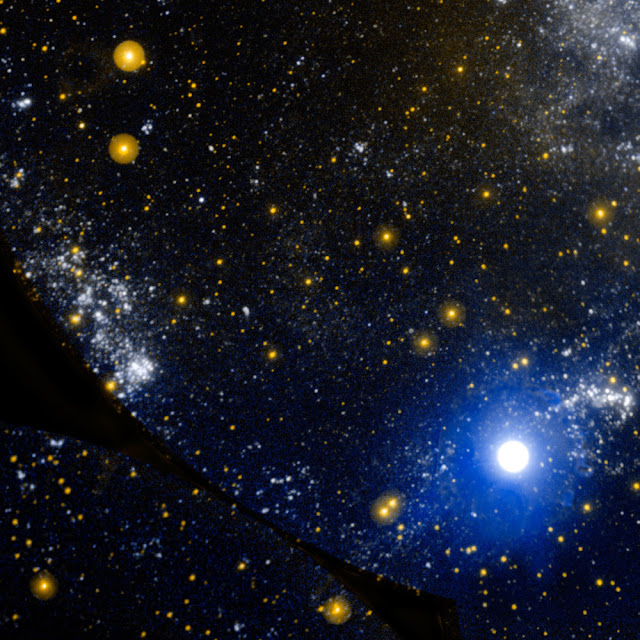Hot stars burn brightly in this new image from NASA's Galaxy Evolution Explorer, showing the ultraviolet side of a familiar face.
 |
| Credit: NASA/JPL-Caltech |
At approximately 2.5 million light-years away, the Andromeda galaxy, or M31, is our Milky Way's largest galactic neighbor. The entire galaxy spans 260,000 light-years across – a distance so large, it took 11 different image segments stitched together to produce this view of the galaxy next door.
The bands of blue-white making up the galaxy's striking rings are neighborhoods that harbor hot, young, massive stars. Dark blue-grey lanes of cooler dust show up starkly against these bright rings, tracing the regions where star formation is currently taking place in dense cloudy cocoons. Eventually, these dusty lanes will be blown away by strong stellar winds, as the forming stars ignite nuclear fusion in their cores. Meanwhile, the central orange-white ball reveals a congregation of cooler, old stars that formed long ago.
When observed in visible light, Andromeda’s rings look more like spiral arms. The ultraviolet view shows that these arms more closely resemble the ring-like structure previously observed in infrared wavelengths with NASA’s Spitzer Space Telescope. Astronomers using Spitzer interpreted these rings as evidence that the galaxy was involved in a direct collision with its neighbor, M32, more than 200 million years ago.
Andromeda is so bright and close to us that it is one of only ten galaxies that can be spotted from Earth with the naked eye. This view is two-color composite, where blue represents far-ultraviolet light, and orange is near-ultraviolet light.
Here below a series of partial views of the Andromeda Galaxy and its neighborhoods, obtained from the
full resolution image published on NASA's website.
 |
| Andromeda's bulge, mainly populated of old, red stars. |
 |
| The blurred reddish oval near the center is Messier 32 (also known as NGC 221 and Le Gentil), a dwarf elliptical galaxy, satellite of Andromeda. Discovered by Le Gentil in 1749, M32 measures only 6.5 ± 0.2 kly in diameter at the widest point. Like most elliptical galaxies, M32 contains mostly older faint red and yellow stars with practically no dust or gas and consequently no current star formation. The dwarf galaxy also contains a supermassive black hole, with an estimated mass between 1.5 and 5 million solar masses. |
 |
| Messier 110 (also known as M110 and NGC 205) is a dwarf spheroidal galaxy that is a satellite of the Andromeda Galaxy. M110 contains some dust and hints of recent star formation, which is unusual for dwarf elliptical galaxies in general. Unlike M32, NGC205 does not show evidence for a supermassive black hole at its center. |
 |
| Near the center of the image, NGC 206 is a bright star cloud in a spiral arm of the Andromeda Galaxy. NGC 206, the richest and most conspicuous star cloud in M31, contains more than 300 stars brighter than Mb=-3.6. It was originally identified by Edwin Hubble as a star cluster but today, due to its size, it is classified as an OB association (a group of young, massive stars of spectral class O and B). |
 |
| Young and bright stars in the extreme outskirt of M31. |
 |
| The ring structure of the spiral arms highlighted by GALEX and Spitzer is clearly visible in this image. |
 |
| Dust and stars in M31. |
Source:







